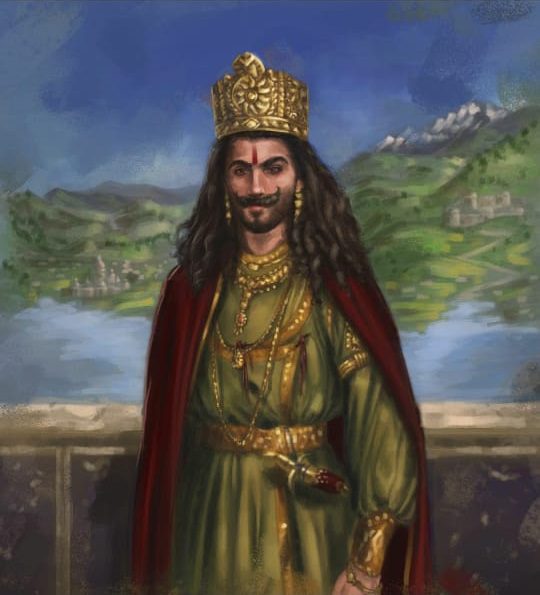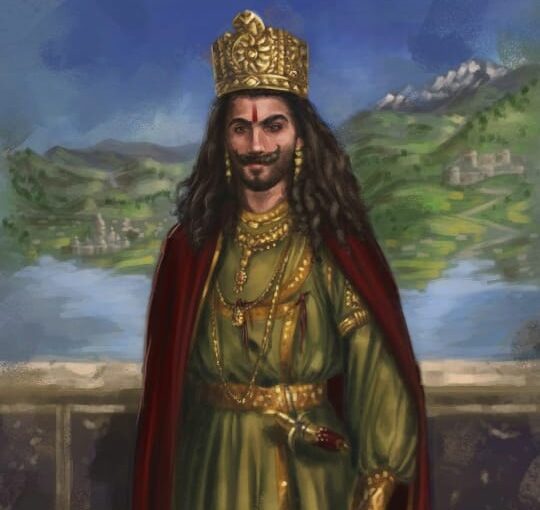Whenever we read Indian History we only hear about the conquest of India by foreign intruders. The Heroic resistance provided by our kings whether in north, south, or northeast in mentioned nowhere in our school books.
One such heroic resistance to foreign invaders was provided by the King of Kashmir. His name was Lalitaditya Muktapida who belonged to the Karkota dynasty of Kashmir.
This Hindu King remained undefeated throughout his reign and expanded his empire in all possible directions. We have very few names in Indian History who remained undefeated and this king of Kashmir is one of them.
Do you know that Maharana Kumbha of Mewar is also an undefeated Hindu King? Click here
Content
Background: Early Life of Lalitaditya
The greatest king of Kashmir as many eminent historians had described him. Kalhana the famous medieval author of India had mentioned the achievements of this great Hindu king of Kashmir. The famous book Rajatarangini which was written in the 12th century had given us the details of the golden age of Kashmir.

The rise of the Karkota of Kashmir was the turning point in Indian history.
This great dynasty was founded by Durlabha-vardhana. Many eminent historians claim that this king was married to the daughter of Baladitya the last king of the Gonanda dynasty.
According to the Chinese traveler, Hiuen Tsang Kashmir during the reign of Durlabha-Vardhana consisted of Takshasila (Rawalpindi District), Simhapura (Salt Range), Urasa (Abbottabad district), Punch, and Rajouri. i.e. the king ruled over northwestern Punjab.
Lalitaditya ascended the throne about 724 AD and was the fifth ruler of the Karkota Dynasty. He was a follower of expansionist policy and wanted to conquer the neighboring kingdoms.
It is believed that he entered into an alliance with Yasovarman and defeated the Tibetans. The Chinese emperors also accepted his diplomatic missions against the powerful Tibetans. The Chinese emperor appreciated this move and recognized the king of Kashmir as a loyal ally. However, it is also a bitter truth that the military aid from the Chinese never came.
But still, Lalitaditya was able to protect his empire and its people from invaders. He also defeated several mountain tribes like Kambojas, Turks, and Dards.
He also defeated the powerful king of Kannauj i.e Yasovarman and emerged as a champion of north India.
Conquests of Lalitaditya Muktapida
Kalhana also mentioned that the king of Kashmir undertook a Digvijaya (World Wide Campaign). According to the author, the king reached the sea coast of east India (Kalinga).
Here the king of Gaur (Bengal) is believed to be the first king to accept the suzerainty and sent several elephants to the king of Kashmir in respect. Later according to Rajatarangini Lalitaditya crossed the Kaveri and captured some islands. From here he went towards the west and conquered Avanti.

However, according to many historians, the southern expedition of Lalitaditya as mentioned in Rajatarangini is very far from reality. But still, it can show us the legacy and the extent of the empire of this great Hindu King.
During his reign, Lalitaditya defeated the Kambhojas, Turks (Tukharas), Tibetans, Dardas, and Arabs. It is believed that Lalitaditya recruited several Chinese mercenaries in his army who were great military strategists. Also when Lalitaditya expanded the empire in the northwest region he started recruiting central Asian Turks.
Frontier Against Arabs
During his reign, the northwestern frontier of the Indian subcontinent was threatened by the Arabs. The new conquers were ferocious warlords who by now had brought the Middle East, North Africa under their banner.
But the advance of the Arabs was bravely halted by the Hindu Monarch of Kashmir. It is believed that king Lalitaditya defeated the Arabs four times during his reign. It is believed that Lalitaditya took some regions of Punjab from the Arabs.
This type of leadership was the reason behind the conquest of places like Turfan, Kuchan of modern-day Xinjiang province of China. His empire also covered the silk route region of modern-day Afghanistan.
Legacy
Lalitaditya through his unending conquests gained huge wealth and resources. He utilized them in an intelligent way and embellished his kingdom by building towns, monasteries, temples, and images of Gods. He also made a new capital named Parihaspura where this Hindu king built many temples. The five major works of Lalitaditya according to Kalhana’s Rajatarangini were Parihasakesava, Muktakesava, Mahaviraha, Govardhanadharana, and Rajavihara.
One famous marvel of Lalitaditya’s reign is the Great Martand Temple of Kashmir. However, now it is in ruins.

Lalitaditya died around 760 CE. During his thirty-six years reign, he protected the empire from several invaders and also promoted art and culture. For his conquests and promotion of art, culture and learning historians had given him the title of Alexandar of Kashmir.
The later kings of this dynasty were not as strong and determinant as Lalitaditya. The Karkotas of Kashmir remained there till the middle of the ninth century.
LIKE WHAT WE ARE DOING? DONATE TO DHARMAYUDH
If you support what we are doing and would like to contribute to help us grow and reach more Indians to teach them more about such forgotten historic Indian Heroes and stories, please consider donating any amount. It will help us grow.

